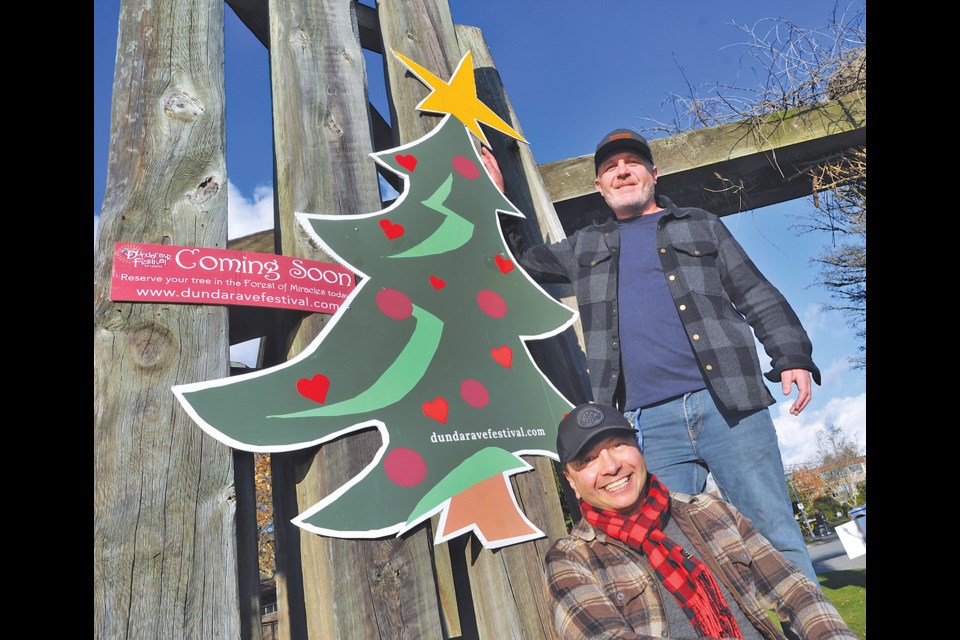Climate change is threatening the viability of one of the North Shore’s treasured Christmas traditions.
The Dundarave Festival of Lights, which brings in hundreds of Christmas trees for its Forest of Miracles, has been told by their suppliers that going forward, their trees will be smaller and twice the price because barely any are surviving B.C.’s annual droughts, heat waves and flooding.
“When we started in 2008, we could literally bring our forest of grand firs to the Dundarave festival. They were our trees. And we found out this year that, no, they’re really hard to come by,” said Michael Markwick, festival organizer. “These seedlings don’t grow past their third year. They just burn up.”
For now, Markwick said organizers are scrambling to figure out how they can continue to bring trees in at a cost that won’t drive off the sponsors and donors who make the event possible. But in the longer term, things are looking even murkier.
“Our tree suppliers are saying maybe in the next five years, we might have to get our trees from south of the valley, like from Oregon, and I can’t imagine doing that,” he said.
Markwick launched the festival in 2008 after his family’s favourite Christmas tree lot at Dundarave Beach became one of the casualties of the global financial crisis. But Markwick sought to reimagine the lot as a social enterprise that would bring the community together.
“I thought, why not do an arts and culture festival that actually allows us to address a community need – homelessness” he said.
More than a collection of beautifully decorated trees, the festival brings live music, dancing, wassailing and Reconciliation events.
In their first year, they raised $25,000 for the Lookout Housing and Health Society. In the years since, they’ve pushed that number to over $1 million, Markwick said. In 2018, the festival’s donations helped Lookout purchase a condo, which they’ve committed in perpetuity to use as affordable housing for low-income seniors.
“The community really takes ownership of solving the problem,” he said. “The North Shore shelter is as busy as Lookout’s shelter in the Downtown Eastside, so demand has continued to ramp up, but the profile has changed. The folks rolling up to the shelter are seniors and young adults.”
But the changing climate’s impacts on Christmas trees isn’t the only new challenge the festival is facing. This year, the non-profit found itself shut out of about $150,000 in grant funding that helps pay for the artists and festival costs, which in turn multiplies how much Lookout will eventually receive.
At its heart, the festival is intended to bring people together, which is critical in today’s political climate, Markwick said, adding that he’s been trying to communicate with MLAs that “it is totally legitimate for a performing arts festival to raise charitable money for a non-profit that’s doing good in the community.”
In the short-term, Markwick said he urges his neighbours to visit the Dundarave Festival of Lights website and purchase a tree, which pays tree growers and artists, and keeps people out of homelessness.
Just as urgent though should be a demand from our political leadership for climate action, Markwick said. The notion of not being able to grow Christmas trees in Canada should be a stark message. While it might have something to do with Santa giving out too many lumps of carbon-intensive coal, it probably has more to do with the lumps of bitumen loaded onto the tankers that pass by Dundarave Beach, he added.
“When you floor it on the highway to climate hell, you put Christmas at risk and everything else,” he said. “We need to get serious about a looking at the structures that cause this catastrophe to unfold. It’s got fingerprints on it. And we can deal with it.”
This year’s Dundarave Festival of Lights festivities kick off on Nov. 30.



